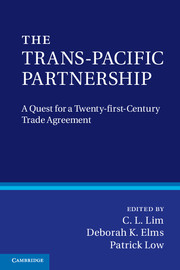Book contents
- Frontmatter
- Contents
- List of Figures and Tables
- Contributors
- Preface
- Acknowledgements
- Disclaimer
- Glossary
- Part I Introduction
- Part II The past: origins of the TPP Agreement
- 2 An overview and snapshot of the TPP negotiations
- 3 US PTAs
- 4 From the P4 to the TPP
- 5 Incorporating development among diverse members
- Part III The present: twenty-first century elements and obstacles
- Part IV The future: high-quality meets regional and global realities
- Part V The TPP negotiations: the quest for quality
- Index
- References
5 - Incorporating development among diverse members
Published online by Cambridge University Press: 05 November 2012
- Frontmatter
- Contents
- List of Figures and Tables
- Contributors
- Preface
- Acknowledgements
- Disclaimer
- Glossary
- Part I Introduction
- Part II The past: origins of the TPP Agreement
- 2 An overview and snapshot of the TPP negotiations
- 3 US PTAs
- 4 From the P4 to the TPP
- 5 Incorporating development among diverse members
- Part III The present: twenty-first century elements and obstacles
- Part IV The future: high-quality meets regional and global realities
- Part V The TPP negotiations: the quest for quality
- Index
- References
Summary
Introduction
The Trans-Pacific Partnership (TPP) is to include several developing countries, in particular, Malaysia, Peru and Viet Nam, as well as a number of advanced countries. The original Trans-Pacific Strategic Economic Partnership (P4), which came into force in 2006, includes Brunei Darussalam, Chile, New Zealand and Singapore. Currently, Australia, Malaysia, Peru, the United States and Viet Nam are negotiating to join the TPP. Canada, Japan and Mexico have expressed interest in joining the talks. None of these states are least developed countries, but Chile, Malaysia, Mexico, Peru and Viet Nam are middle income countries. Chile, Malaysia, Mexico and Peru are classified by the World Bank as “upper middle income countries,” while Viet Nam is classified as a “lower middle income country.” The inclusion of these middle income countries, and especially Viet Nam, raises issues of how a preferential trade agreement should deal with the problems of developing countries. For the US, Viet Nam also raises issues relating to labour rights, intellectual property protection, transparency and human rights. In addition, there are hopes that the TPP will grow over time to include additional countries, which may include more developing countries, such as the Philippines, Thailand or Indonesia.
Given the current state of multilateral trade negotiations, it appears that preferential trade agreements (PTAs) will serve as the main vehicle for increased liberalization in the short term. The question arises, therefore, whether the TPP should and could include provisions for special treatment for developing countries, and what other aspects of the TPP have special effects on the growth of developing countries. An important range of issues relates to the preservation of policy space for developing countries to take measures to promote their development. Preferential trade agreements do not normally have significant arrangements for so-called “special and differential treatment,” which at the WTO includes expanded market access for developing countries in developed country markets, special exceptions from liberalization for developing countries, abstention by developed countries from demands for reciprocal market opening of developing countries, and technical assistance or aid for trade. Since the TPP is hoped to have an expanding membership, and is heralded as a “twenty-first century” trade agreement, it is worthwhile to consider what types of special provisions would be appropriate to be included relating to developing countries.
- Type
- Chapter
- Information
- The Trans-Pacific PartnershipA Quest for a Twenty-first Century Trade Agreement, pp. 82 - 106Publisher: Cambridge University PressPrint publication year: 2012

